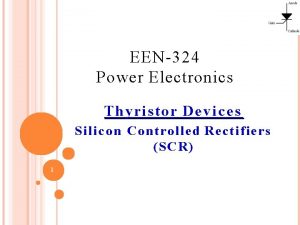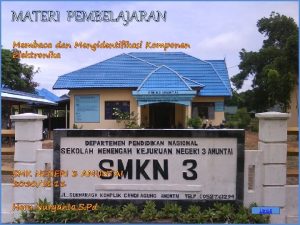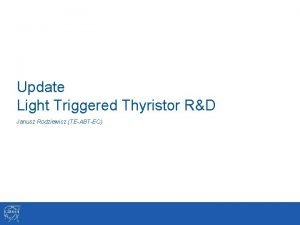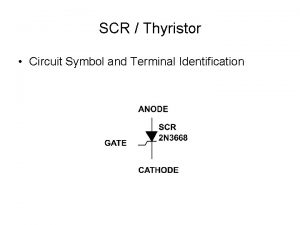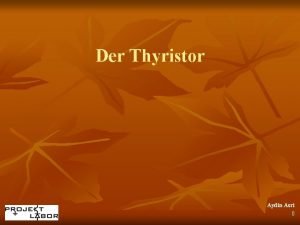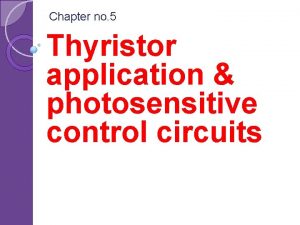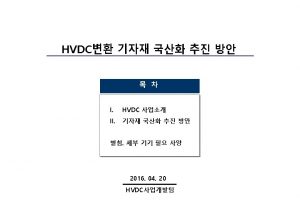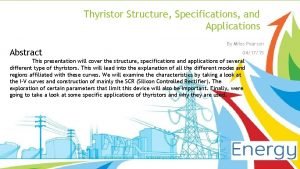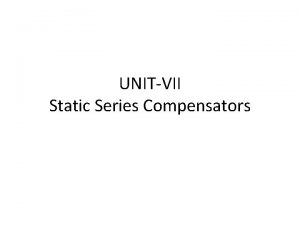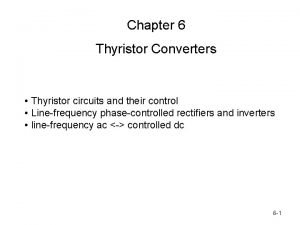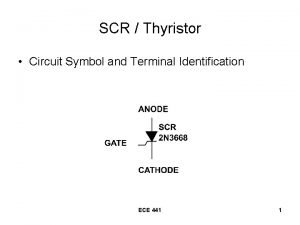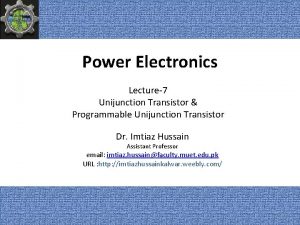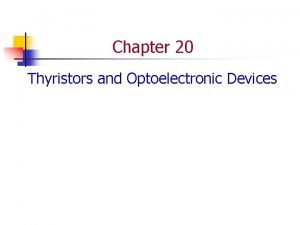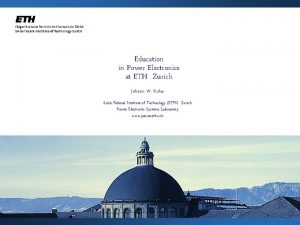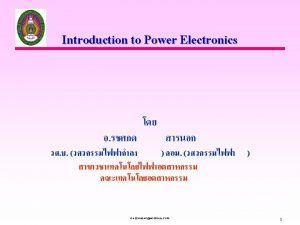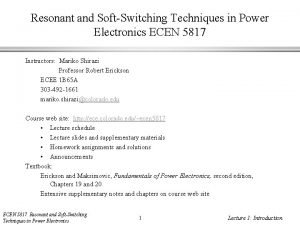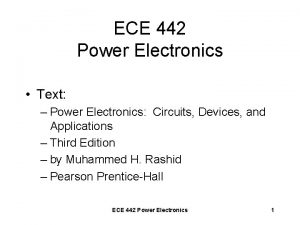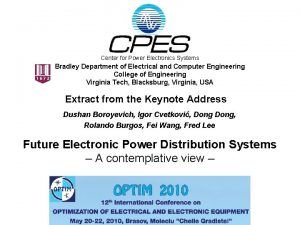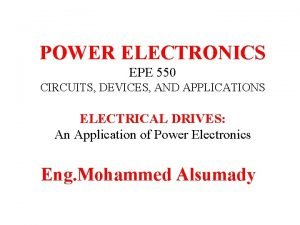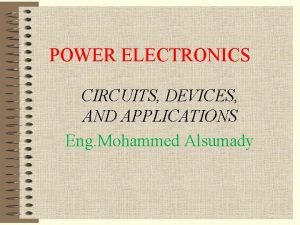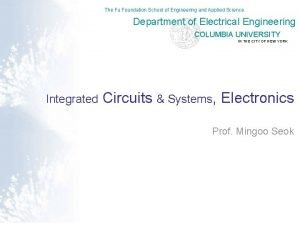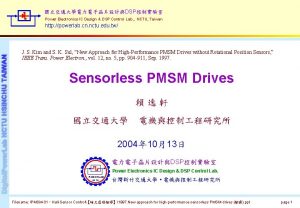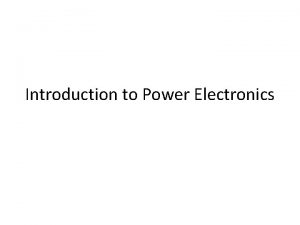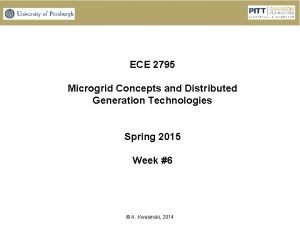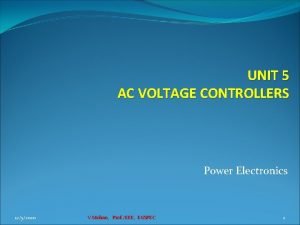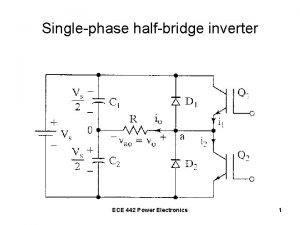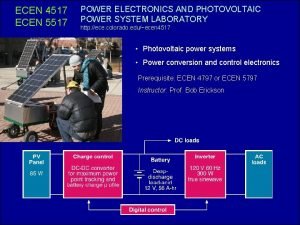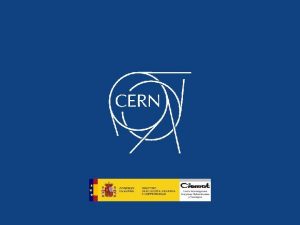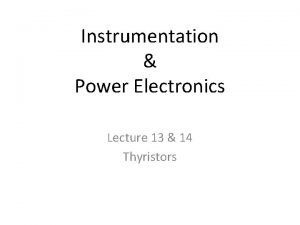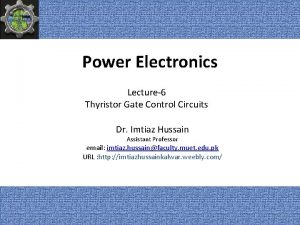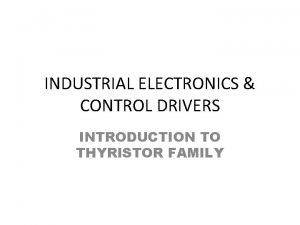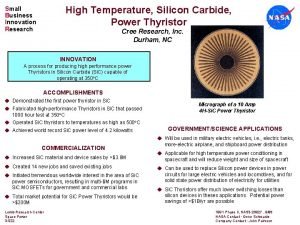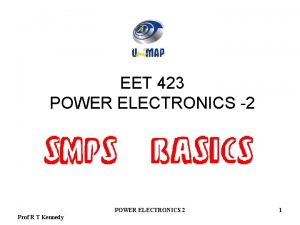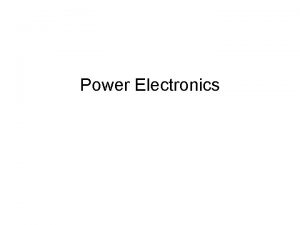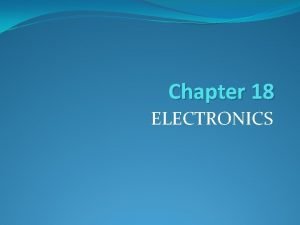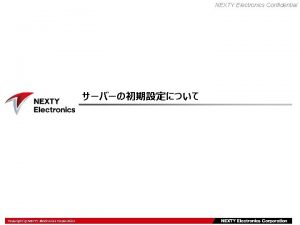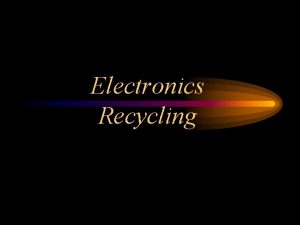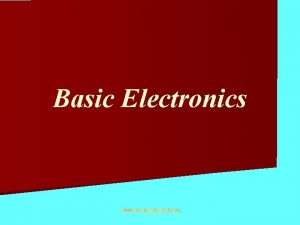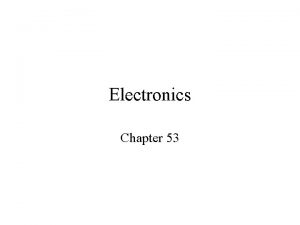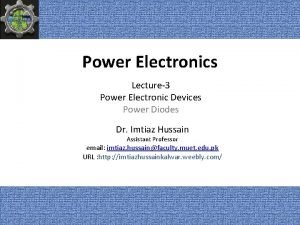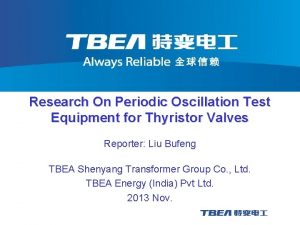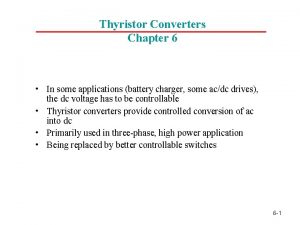EEN324 Power Electronics Thyristor D e v i


































- Slides: 34

EEN-324 Power Electronics Thyristor D e v i c e s S i l i c o n Controlled Rectifiers (SCR) 1

Power Semiconductor Switches Power Diodes P o w e r Transistors Thyristors 2 layer d e v i c e Device � � 3 layer D e v i c e 4 layer Thyristor d e v i c e s c a n c o n v e r t a n d control large a m o u n t s of p o w e r i n AC or DC s y s t e m s w h i l e u s i n g v e r y l o w p o w e r for control. Thyristor family i n c l u d e s 1 Silicon controlled s w i t c h (SCR) 2 Gate-turnoff thyristor (GTO) 3 - Triac 4 Diac 5 Silicon controlled s w i t c h (SCS) 6 - Mos-controlled s w i t c h (MCT) 2

INTRODUCTION � SCR is most popular of thyristor family due to its Fast switching action , small size and high voltage and current ratings. � It is commonly used in power electronic applications. � SCR has 3 terminals (gate provides control) � SCR is t u rn ed on by applyin g +ve ga te sign al when anode is +ve with repect to cathode. � SCR is turned off by interrupting anode current. PNPN structure Sym bol 3

TWO TRANSISTOR MODEL OF SCR � Gate requires small positive pulse for short duration to turn S C R on. Once the device is on, the gate signal serves no useful purpose and can be removed. 4

SCR CHARACTERISTIC CURVE 5

IDEAL CHARACTERISTIC OF SCR 6

SCR RATINGS (a) SCR Current Ratings 1 - Maximum Repetitive RMS current Rating � Average on-state current is the maximum average current value t h a t can be carried by the SCR in its on state. � RMS value of nonsinusoidal waveform is simplified by approximating it by rectangular waveform. � This approximation give higher RMS value, but leaves slight safety factor. 7

� Average � Form value of pulse is factor is 8

� Knowing the form factor for given waveform, RMS current can be obtained from I � Maximum RMS = f o(I AVE ) repetitive RMS current is given by I � Conduction = f o(I T(AVE )) T(RMS) angle verses form factor Conduction angle (θ) F o r m factor (fo) 20° 5. 0 40° 3. 5 60° 2. 7 80° 2. 3 100° 2. 0 120° 1. 8 140° 1. 6 160° 1. 4 9

CONDUCTION ANGLE � Duration for which S C R is on. It is measured as shown 10

2 - Surge Current Rating Peak anode current t h a t SCR can handle for brief duration. 3 Latching current Minimum anode current t h a t must flow through the SCR in order for it to stay on initially after gate signal is removed. 4 Holding Current Minimum value of anode current, required to maintain SCR in conducting state. 11

(B) SCR VOLTAGE RATINGS 1 Peak repetitive forward blocking voltage Maximum instantaneous voltage t h a t SCR can block in forward direction. 2 Peak Repetitive Reverse Voltage Maximum instantaneous voltage t h a t SCR can withstand, without breakdown, in reverse direction. 3 Non-repetitive peak reverse voltage Maximum transient reverse voltage t h a t SCR can withstand. 12

(C) SCR RATE-OF-CHANGE RATINGS 1 (di/dt rating) Critical rate of rise of on-state current. It is the rate a t which anode current increases and must be less t h a n rate a t which conduction area increases. To prevent damage to SCR by high di/dt value, small inductance is added in series with device. Vaue of required inductance is L>= Vp (di/dt)max 2 dv/dt rating Maximum rise time of a voltage pulse t h a t can be applied to the SCR in the off state without causing it to fire. Unscheduled firing due to high value of dv/dt can be prevented by using RC snubber circuit. 13

(D) GATE PARAMETERS 1 Maximum Gate Peak Inverse Voltage Maximum value of negative DC voltage t h a t can be applied without damaging the gatecathode junction. 2 Maximum Gate Trigger Current Maximum DC gate current allowed to t u r n on the device. 3 Maximum gate trigger voltage DC voltage necessary to produce maximum gate trigger current. 4 Maximum Gate Power Dissipation Maximum instantaneous product of gate current and gate voltage t h a t can exist during forward-bias. 5 Minimum gate trigger voltage Minimum DC gate-to-cathode voltage required to trigger the SCR. 6 -Minimum gate trigger current Minimum DC gate current necessary to t u r n SCR on. 14

S e r i e s a n d Parallel SCR C o n n e c t i o n s 15

SCRs are connected in series and parallel to extend voltage and current ratings. For high-voltage, high-current applications, seriesparallel combinations of SCRs are used. 16

SCRS IN SERIES � Unequal distribution of voltage across two series SCRs. � Two SCRs do not share the same supply voltage. Maximum voltage t h a t SCRs can block is V 1+V 2, not 2 VBO. 17

� Resistance equalization � Voltage e q u a l i z a t i o n 18

� RC e q u a l i z a t i o n for SCRs c o n n e c t e d i n series. 19

SCRS IN PARALLEL � Unequal � Total current sharing between two SCRs is shown: rated current of parallel connection is I 1 +I 2 , not 2 I 2. 20

� With unmatched SCRs, equal current sharing is achieved by adding low value resistor or inductor in series with each SCR, as shown below. � Value of resistance R is obtained from: R=V 1 -V 2 I 2 -I 1 21

� Current sharing in SCRs with parallel reactors Equalization using resistors is inefficient due to � Extra power loss � Noncompansation for unequal S C R turn-on and turn-off times. � Damage due to overloading SCRs with center-tapped reactors is shown below. 22

SCR Gate-Triggering Circuits 23

� Triggering circuits provide firing signal to t u r n on the SCR a t precisely the correct time. � Firing circuits m u s t have following properties 1. Produce gate signal of suitable magnitude and sufficiently short rise time. 2. Produce gate signal of adequate duration. 3. Provide accurate firing control over the required range. 4. Ensure t h a t triggering does not occur from false signals or noise 5. In AC applications, ensure t h a t the gate signal is applied when the SCR is forward-biased 6. In three-phase circuits, provide gate pulses t h a t are 120° apart with respect to the reference point 7. Ensure simultaneous triggering of SCRs connected in series or in parallel. 24

SCR Turnoff (Commutation) Circuits 25

� What is Commutation? The process of turning off a n SCR is called commutation. It is achieved by 1. Reducing anode current below holding current 2. Make anode negative with respect to cathode � Types of commutation are: 1. Natural or line commutation 2. Forced commutation 26

SCR TURNOFF METHODS 1. Diverting the anode current to a n alternate path 2. Shorting the SCR from anode to cathode 3. Applying a reverse voltage (by making the cathode positive with respect to the anode) across the SCR 4. Forcing the anode current to zero for a brief period 5. Opening the external path from its anode supply voltage 6. Momentarily reducing supply voltage to zero 38

Other m e m b e r s of Thyristor F a m i l y 28

OTHER TYPES OF THYRISTORS 1. Silicon Controlled Switch (SCS) 2. Gate Turnoff Thyristor (GTO) 3. DIAC 4. TRIAC 5. MOS-Controlled Thyristor (MCT) 29

1. SCS St r ucture Symbol Equivalent circuit for SCS 30

(2) GTO St r uct u re Symbol GTO Ideal VI cha r a ct erist iccs 31

(3) DIAC Stru cture Symbol VI characteristics of diac 32

(4) TRIAC Stru cture Symbol SCR equivalent circuit 33

TRIAC VI CHARACTERISTICS 34
 Power triangle
Power triangle Scs thyristor
Scs thyristor Membaca dan mengidentifikasi komponen optik
Membaca dan mengidentifikasi komponen optik Janusz rodziewicz
Janusz rodziewicz Scr thyristor symbol
Scr thyristor symbol Thyristorsteller funktionsweise
Thyristorsteller funktionsweise Thyristor circuits applications
Thyristor circuits applications Thyristor valve in hvdc
Thyristor valve in hvdc Thyristor structure
Thyristor structure List of static series compensators
List of static series compensators Thyristor
Thyristor Pengertian thyristor
Pengertian thyristor Symbol for thyristor
Symbol for thyristor Put in electronics
Put in electronics Silicon unilateral switch symbol
Silicon unilateral switch symbol Eth power electronics
Eth power electronics Power electronics
Power electronics Power electronics
Power electronics Power electronics
Power electronics Center for power electronics systems
Center for power electronics systems Power electronics
Power electronics Power electronics circuits devices and applications
Power electronics circuits devices and applications Columbia university power electronics
Columbia university power electronics Dsp in power electronics
Dsp in power electronics Ampegon power electronics ag
Ampegon power electronics ag Introduction to power electronics
Introduction to power electronics Colorado boulder power electronics
Colorado boulder power electronics Rectifier power electronics
Rectifier power electronics Ac regulators in power electronics
Ac regulators in power electronics Ece 442
Ece 442 Power electronics
Power electronics Power bi power point
Power bi power point Solar power satellites and microwave power transmission
Solar power satellites and microwave power transmission Power of a power property
Power of a power property Power absorbed or supplied
Power absorbed or supplied

